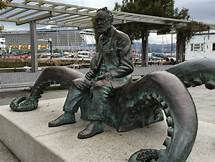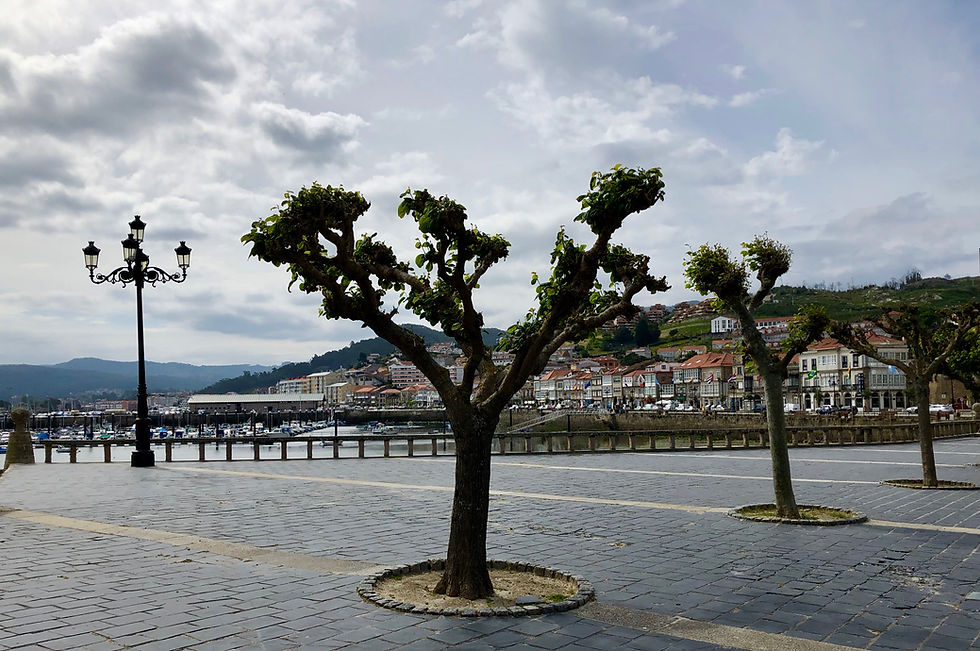España, te amo!
- Susan Nash
- May 7, 2019
- 4 min read
May 6, 2019, Vigo, Spain — I do love Spain. After two volunteer trips to help Spaniards improve their English, plus a couple stops on last year’s cruise, it was great to be back, albeit briefly.
The average temperature here is 57F. That’s exactly what it was this morning. Tho’ other places in interior Spain can get very hot in the summer. The climate here is oceanic, not Mediterranean — like our Pacific Northwest. Lots of native oaks and palm trees, plus eucalyptus imported from Australia. The highway was lined with mile after mile of flowering, yellow Scottish broom. And we saw full-sized camellia trees, originally from Japan, loaded with blossoms.
Vigo (population 300,000) is a major port and industrial center in the southwestern corner of the most northwestern corner of Spain... Galicia (pop. 2.8 mm). You know, the part of Spain where red-headed Celt-blooded Spaniards play bagpipes. It’s one hour north of Portugal’s second largest city, Porto, where I stopped last year. Which is why the Galician language (spoken in addition to Spanish) resembles Portuguese.
We had sailed up the aptly named Vigo Estuary to our berth in the aptly named Vigo Port, which we shared with cranes and offloaded containers and container ships that export cars, fish, processed fish, other processed foods, natural stone and granite. The three most important companies in Galicia are Citroën, Peugeot, and Zara, the clothing chain. Vigo is also a big shipbuilding locale, making large vessels such as tankers and tugboats. In the small boat department, there’s a lot of recreational sailing.
Two hundred years ago it was little fishes that attracted people to this area: sardines. Today, suspended ‘nursery beds’ floating in the straits are where mussels and oysters are ‘born.’ The gestation period of a mussel grown this way is 18 months, and each bed can contain 200 tons.
Parts of the city are built over an ancient Roman settlement. We drove through a tunnel that’s on top of a Roman necropolis. Speaking of the dead, cemeteries here are created near the sea — so the dead can take a boat across to the other side.
Our bus took us up Monte de Guía to see the Vergin de las Nieves (Our Lady of the Snows) church at the top...

Coming down from the Monte, we drove through the city. This first shot is the façade — and only the façade — of a building that used to be. I had a weird color problem with my iPhone — a bunch of pix are decidedly green.





On the Vigo waterfront...

I didn’t see this with my own eyes, but: To finally quote a source other than Wikipedia and Beryl Markham, here’s what www.turismodevigo.org had to say about the statue you see here of, yes, a man sitting atop a giant squid: ‘The French writer Jules Verne devoted one of the chapters in 20,000 Leagues Under the Sea to the Bay of Vigo, which bolstered the legend of the treasure of Rande. The author’s popular character Captain Nemo, thanks to his equally famous submarine, the Nautilus, was able to salvage the gold that had been lost underwater during the Battle of Rande and use it to pay for his adventures.’ The gold was aboard 42 Spanish galleons.
Leaving the city we went out into the country en route to Baiona, or Bayona. The Romanesque-style Ramallosa Bridge over the Val Miñor dates from the 12th century.

Our destination was the Parador Conde de Gondomar on Mount Royal. Paradors are fancy (4- and 5-star) government-run (yes, and it works!) hotels created in historic structures. Spain is famous for them. A castle or a convent might become one, or in this case, one was built (in 1963) on the grounds of a 16th-century fortress. The hotel part is 50+ years old, but the surrounding parkland, fort and battlements are old.
There’s been some form of fort here since the 8th century, built to defend against the Moors (see below), then the Vikings, then the Celts, then the Romans, under Julius Caesar, our old friends the Portuguese, the British under Sir Francis Drake, the Turks and finally the French, who, in 1808, annexed Spain to the Napoleonic Empire. The invaders were seeking territory, but also metals such as iron, which could be traded with other European countries.

The Moors first invaded Spain in the 8th century — and lasted 700 years, until the final battle of la Reconquista (reconquest) in 1492, when Ferdinand and Isabella’s forces took the last Moorish stronghold at Granada.
The modern hotel...



We were served a few not-very-creative tapas and a nice white Albariño wine. Hey, it’s 5 o’clock somewhere.
Almost out of the Parador, we spotted sailboats between the crenellations. This would be a wonderful place to sail.

I love pollarded trees — to me they’re a symbol of Europe.

La Pinta was the first of Columbus’s ships to make it back here, in 1493 — so the people of Baiona were the first Spaniards (who weren’t on the ship) to find out about the New World and spread the news. They’re proud of it.

We did a walkabout through the Old Quarter of Baiona (population 14,000 now: 45,000 in the summer!). It was charming. This is a functioning convent — though it has only 10 nuns now. They bake sweets to sell, and communion wafers.


The chapel inside the convent.

View towards the harbor, from the Old Quarter...

The 3 plaques up the side of the hotel are the Nina, the Pinta, and the Santa Maria. The Santa Maria had run aground off Haiti and did not make it back to Spain.

Back at the ship, we were all offered the most famous local drink as we went up the gangway: Sangria.
Next up: Traversing the Bay of Biscay — ahead of the storm. #








Comments